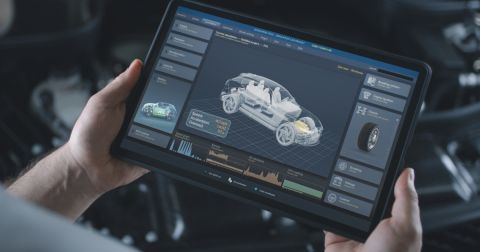How Do I Connect Design Data and Requirements for Faster Design and Fewer Errors?

The intricacies of electronic design and the challenges they present have never been more pronounced. As devices become more interconnected, the need for efficient, error-free design processes becomes paramount. Modern electronic design challenges emphasize the importance of connecting design data with requirements. With tools like Altium's requirements management powered by AI intelligence, you can manage complexities faster and with fewer errors. Discover how!
Modern Design Process Challenges
The proliferation of smart devices in our daily lives has led to a staggering increase in the complexity of electronic designs. Over the past 40 years, chip usage has surged by 100 times. To put this in perspective, while an electric vehicle from a few decades ago might have contained 10 to 20 chips, today's vehicles are equipped with over 2,000 chips.
Concurrently, the software embedded in these products has grown fifteen-fold in the last decade, escalating from 10 million lines of code to a whopping 150 million lines. This increase in electronics usage has significantly impacted costs. For instance, in the 1970s, electronics accounted for about 10% of a vehicle's cost. Today, that figure stands at 40%, and projections indicate that by 2030, electronics will constitute half of a vehicle's total cost.
The challenges don't end there. The production timelines for these intricate products have been slashed by three times. What used to take five years now needs to be accomplished in just two. This urgency has driven many companies to adopt agile methodologies, borrowing principles from software development. By segmenting designs into project phases, companies can foster continuous collaboration and improvement. This approach emphasizes faster iterations, allowing teams to refine design concepts through simulation codesign and coengineering. Such strategies demand extensive simulation and swift prototyping to test outcomes and make quick adjustments.
Historically, electronics have been a vulnerable point in the hardware development chain. Despite bridging the physical and digital realms of design, electronic data often exists in isolated silos. Information transfer between these silos is manual and cumbersome, involving static file formats, printouts, and even physical exchanges like flash drives. This inefficient process consumes an average of 159 hours per engineer annually. Such communication gaps can compromise product quality, leading to defects and tarnishing a company's reputation.
Furthermore, the absence of traceability prolongs the time required to trace design changes. It's not uncommon for up to 80% of designs to undergo last-minute component alterations due to cost or availability constraints. Such abrupt changes, especially without backup options, can derail the entire design process. According to Lifecycle Insights, on average, companies face 2.8 board respins, costing around $46,000 per respin. Minimizing respins and enhancing communication is thus beyond the question.
Crafting Connectivity Across Design Domains
That’s why at Altium, we recognize that PCB design is one piece of the puzzle. The most significant challenges arise at the intersections of various design domains. Cross-functional collaboration, while essential, can be a minefield of miscommunication, especially when teams "speak different languages" in terms of design intent.
Altium is a platform created to unify diverse teams and facilitate communication. It serves as a central hub for electronics design, bringing together professionals from various functions to collaborate without obstacles.
The overarching goal is to ensure everyone is "at the same table" with a platform that offers comprehensive visibility throughout the development process, spanning all functions and domains. Altium enables different applications and integrations that assist you in your general product development process. Today, we’ll focus on requirements management.
How to Connect Design Data and Requirements?
Requirements are pivotal not just at the start of a design but remain crucial throughout its lifecycle. They need to be framed in the proper context to ensure a project's success.
The core challenge Altium's requirements management addresses is enhancing the visibility of your requirements. This tool provides a structured methodology to ensure that requirements are applied accurately and in the right context to confirm their compliance. It integrates real-time updates for both requirements and design data. You can place requirements directly within any aspect of the design data, be it the schematic or the PCB layout, and you’ll get unparalleled digital traceability, allowing teams to track the who, what, when, where, and why of all requirements.

This holistic approach impacts the entire electronics lifecycle. It begins with jotting down initial requirements and delves deep into concurrent design. The iterative loops primarily occur between detailed design simulations, reviews, and technical change management. The goal is to ensure that the final electronic design aligns with the initial requirements, undergoes the necessary reviews, and maintains full traceability.
From Product Specification to Design and Verification
Requirements management in Altium helps you encapsulate the entire journey from product specification to design and verification. By embedding engineering data within your requirements, you adopt a data-driven approach. For instance, if a requirement specifies a voltage of 5 volts, this value is linked to formulas, calculations, and simulations. This interconnectedness ensures the entire engineering team is aligned, bridging the gap between systems engineers, electronics designers, and the subsequent QA process.
The final step involves verifying and validating the product. The aim is to confirm that the system design adheres to the requirements. This is where automated verification and validation play a crucial role. The system can instantly verify that a requirement has been implemented and generate verification matrices to ensure comprehensive validation.
In practical terms, consider the development of a vehicle. If a stakeholder requests an increase in the car's range, an engineer might augment the number of battery modules. Altium's requirements management recalculates the battery's properties and related attributes like car mass and braking distance. This ensures full traceability of changes and their system-wide impact. You can then rerun simulations, update documentation, verify requirements, and notify the relevant engineers. What traditionally took weeks of manual updates, meetings, and emails is now accomplished in mere seconds, ensuring everyone remains synchronized during the design process.
3 Major Benefits of Requirements Management in Altium
#1 Reduce Rework with Up-To-Date Specifications
Avoid rework with up-to-date specifications. Altium's requirements management ensures that changes trigger automatic updates across your project, keeping everyone aligned and reducing errors. Track changes, compare versions, and use AI to spot inconsistencies instantly. With self-updating specifications and linked requirements, updates automatically propagate throughout your designs, preventing costly rework and miscommunication.
The app is equipped with comment functionality so you can interact with others directly within the context of your design. Just as you'd place a comment on a specific point or area, you can now integrate requirements in the same intuitive manner.

#2 Save Time with Automatic Verifications
Speed up your product development by resolving non-compliant design issues faster with continuous, automatic verifications. Our portal tracks technical values within requirements in real-time, ensuring your product meets specifications and reducing delays. With versioned verification history and self-updating dashboards, you’ll always have up-to-date insights for quick decision-making.
#3 Manage Project Complexity with Requirements Traceability
Simplify the complexity of your engineering projects by linking requirements directly to design elements and documentation. This traceability keeps your team aligned, reduces risks, and improves outcomes as your project grows. With tracked changes, self-updating reports, and built-in communication tools, you stay informed and in control throughout the project lifecycle.
Why is Dynamic Requirements Visibility Useful?
Dynamic requirements visibility allows you to see changes to requirements as they happen, ensuring you're always working with the latest information. Here are some functionalities you can find useful:
- Connect Requirements to Designs: Electrical engineers have the latest values and up-to-date specifications and can view requirements in context on their schematics and PCB designs.
- Parametrized Requirements: Requirements are not just in text format. Important technical values can also live inside them, allowing for automatic and continuous verification throughout your project.
- Requirements Traceability: Track and trace each requirement throughout the entire project lifecycle. Ensure every design decision and test case can be traced back to its original requirement.
- Self-Updating Specifications: Updates and changes made to requirements are propagated across all areas where they are referenced in the project.
- Self-Updating Dashboards and Reports: Engineering managers have instant access to important information about their projects and can quickly provide up-to-date reports to stakeholders.
- Versioning and Requirements History: See the historical changes made to requirements and compare requirements across different versions.
- AI-Powered Requirements Quality Check: Use AI to check the quality and clarity of requirements
- Verification & Validation Management: Create, organize, and track verification activities in a single place.
- Easy Requirement Imports: Import requirements from your existing requirement library using an .xls or CSV file.
Learn More
Requirements management in Altium accelerates the design process, offers insights into the implications of changes, and facilitates risk assessments. The real-time data links and dynamic requirement navigation provide immediate clarity, eliminating the need to switch between platforms. This bi-directional connection ensures everyone understands the design intent and any alterations made.













